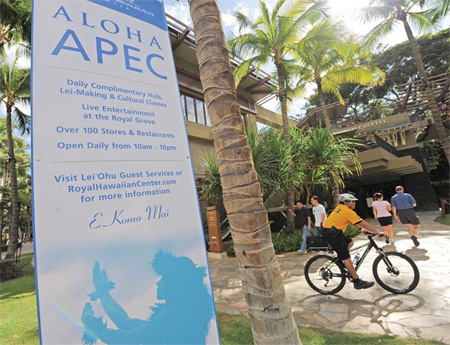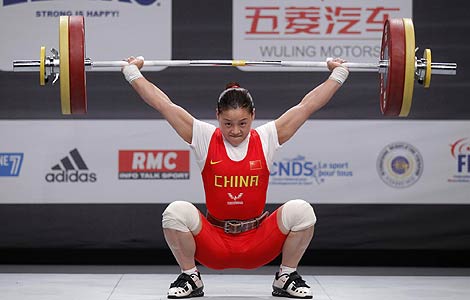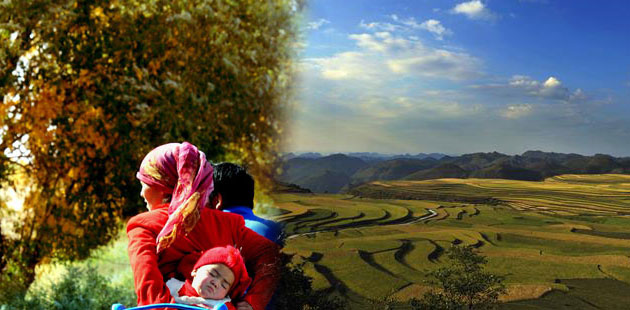Regional integration tops APEC agenda
Updated: 2011-11-11 09:03
(China Daily)
|
|||||||||
|
A policeman patrols on a bicycle past a banner highlighting the APEC meeting in Honolulu, Hawaii on Nov 9. Robyn Beck / AFP |
China, US to discuss ways to further improve bilateral ties
The world's two largest economies, China and the United States, are expected to promote regional integration - but through different channels - in the aptly themed Asia-Pacific Economic Cooperation (APEC) forum in Hawaii, from Nov 11 to Nov 14.
President Hu Jintao will meet his US counterpart Barack Obama, Japanese Prime Minister Yoshihiko Noda, as well as leaders from Peru, Vietnam and Canada on the sidelines of the 19th APEC Leaders' Meeting.
Analysts say the Hu-Obama meeting - the 11th since the latter took office - will set a positive tone and improve the Sino-US relationship amid tensions over bilateral trade and currency issues.
But these improvements may be effective only in the short term due to complexities in bilateral relations and the frequency of summits that have mitigated their significance, says Yan Xuetong, dean of the Institute of Modern International Relations at Tsinghua University.
China has said the primary goals of the US at the APEC meeting - establishing regional free trade and an environmental policy - are useful but "too ambitious" for developing economies in the Asia-Pacific.
Some of Washington's expectations are "beyond the reach of a majority of developing economies", Assistant Foreign Minister Wu Hailong said at a news briefing in Beijing on Nov 7.
The developing economies have already expressed concerns to this effect, and every side expects "balanced and concrete results" from the meeting, he said.
"We hope that all parties will demonstrate flexibility - they need to pay attention to the different development stages of members of APEC, especially developing countries," Wu said.
The US aims to persuade the APEC economies to agree on a deal that will lower their tariffs on a broad range of environmental goods - from solar panels to fluorescent light bulbs - to 5 percent by the end of 2012.
Seeking to promote clean technologies, the move is supported by companies such as General Electric Co and Applied Materials Inc. Karan Bhatia, vice-president of global government affairs and policy at GE, a world-leading company in wind energy, has said people at the company are "keeping our fingers crossed, hoping it comes together".
GE is classified as a "gold partner" of this week's APEC. Its Vice-Chairman John Rice is among the many corporate leaders who will attend the meeting.
Average US tariffs are 1.4 percent compared to China's roughly 7 percent for the list of 153 green products proposed by the US, Assistant Minister of Commerce Yu Jianhua said at the briefing on Nov 6.
Among the 21 APEC member economies, Malaysia imposes a 30-percent tariff on fluorescent bulbs, compared with an average tariff of 9 percent, according to World Bank figures. Indonesia and the Philippines, also APEC members, maintain 15 percent tariffs on solar photovoltaic panels, of which China is the world's top exporter.
"Some economies on one hand promote free trade of green products and services, and at the same time abuse trade remedies and protectionism on trade of green products within the APEC region," Yu said.
Since October, the US arm of a German solar firm has been filing an anti-dumping complaint against its Chinese counterparts to the Obama administration.
On Nov 8, the US International Trade Commission held a hearing in Washington on the complaint, filed by the US division of Germany's SolarWorld.
The company has asked the US to impose retaliatory tariffs - duties of more than 100 percent - on China's solar imports to the US.
While the US Commerce Department is expected to accept the petition and start an investigation that could eventually lead to imposed duties, a group of 25 manufacturers and installers said on Nov 8 that they are banding together to oppose SolarWorld's complaint, calling it "short -sighted".
The complaint may result in higher-priced solar panels and disrupt the growth of the struggling solar market in the US, the coalition said.
Yu said in Beijing on Nov 7 that any relevant discussion at the APEC meeting should be in line with ongoing World Trade Organization (WTO) discussions.
The 21 APEC members account for over 43 percent of global trade and 55 percent of the global economic output. The group's agreements, unlike those of the WTO, are non-binding.
The US has been pressing for years to liberalize trade on green goods and services in World Trade Organization talks "with little success", the Wall Street Journal reported. Obama's efforts on the issues to be discussed at the APEC meeting "face the same divisions that have stymied the WTO campaign", it said.
Su Hao, director of the Asia-Pacific Research Center at China Foreign Affairs University in Beijing, said by pushing for the regional liberalization of green products and services, the US aims to deepen its trade advantages in the Pacific Rim, and make the developing economies more dependent on its high-end technology.
In Washington, US Trade Representative Ron Kirk on Nov 7 said these expectations of the Obama administration are not ambitious. The US is "always going to try to push the envelope," he said.
The meeting, if it succeeds, "will be important in promoting regional cooperation in the Asia-Pacific area, facilitating world economic recovery and growth", said Zhang Yesui, China's Ambassador to the US.
"The Asia-Pacific area is the most energetic area in the world economy, but it also faces many difficulties and challenges in the region," Zhang said, stressing that "its member economies are developing at different levels".
At the Hawaii meeting, the first time the US has hosted an APEC meeting since the 1993 one in Blake Island, Washington state, the Obama administration will work to set up the Trans-Pacific Partnership (TPP). If signed, it will become the country's largest trade deal since 1994, when the North American Free Trade Agreement with its two immediate neighbors, Canada and Mexico, came into effect.
The TPP is being negotiated among the US, Australia, Brunei, Chile, Malaysia, New Zealand, Peru, Singapore, and Vietnam, all of which are APEC members. Some analysts believe the world's third largest economy, Japan, will also be asked to join in during the APEC meeting.
With an open attitude about integration frameworks including the US-centric TPP, China nonetheless hopes that the Association of Southeast Asian Nations (ASEAN) +3 (China, Japan and South Korea) will take a leading role.
The TPP should be open, not exclusive, said Yu, adding that China has not been invited to join the talks.
China remains uncertain how the TPP will affect regional economic performance, said Wang Yuzhu, of the Institute of Asia-Pacific Studies at the Chinese Academy of Social Sciences.












